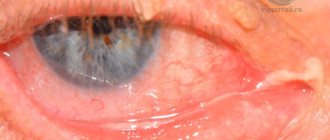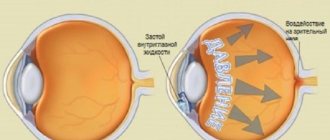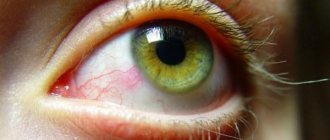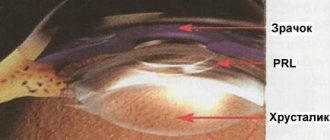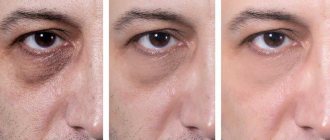Severe itching in the corners of the eyes indicates an allergic reaction or the development of a disease. The presence of the disease is indicated by the accompanying symptoms of suppuration, redness, swelling and lacrimation. If the condition appears one-time, then no treatment is required. To eliminate persistent itching, you need to contact an ophthalmologist, who will prescribe antibiotic and antibacterial drops and ointments.
You can also get rid of itching using folk remedies. To do this, prepare decoctions and infusions from medicinal plants to wipe the corners, make masks, and apply compresses to the eyes.
Reasons for appearance
Itchy eyes in the inner corners near the bridge of the nose due to many reasons that can be divided into 3 groups:
- factors associated with exposure to external stimuli;
- infectious eye diseases;
- reasons of a systemic nature associated with disturbances in processes in the body.
The first group includes:
- eye fatigue associated with prolonged overexertion;
- irritation due to strong winds, frosty weather, exposure to sunlight;
- allergic reaction to external irritants: getting dust, pollen, animal hair, cosmetic residues into the eyes;
- reaction to chemical irritants: contact with skin of aggressive substances, household chemicals;
- a bite of an insect;
- injury to the mucous membrane by a foreign object.
Causes of itching in the eye area that are not associated with the development of diseases also include:
- avitaminosis;
- undergone surgery on the visual organ;
- dry eye syndrome associated with a decrease in the amount of tear fluid secreted.
The main causes of itching in the bridge of the nose and in the corners of the eyes
- Stressful situations, complex work schedules, frequent overwork, high tension and insufficient time to sleep at night.
- Poor nutrition, unbalanced diet and the development of vitamin deficiency.
- Use of low quality cosmetics.
- Prolonged wearing of contact lenses, drying out of the mucous membrane from long hours of work at the computer.
- Diseases of the endocrine system and internal organs.
- Allergic reactions to food, pollen and other irritants.
- Poor environmental conditions and hazardous working conditions (dust, soot, chemicals).
- Poor hygiene and blocked tear ducts.
- Development of eye inflammation as a result of infection.
Possible diseases
If we talk about infectious causes, various inflammatory diseases of the visual organ can provoke itching in the area of the corners of the eyes.
These include:
| Conjunctivitis | Inflammatory damage to the mucous membrane of the eye. Has a viral or bacterial etiology. | Symptoms:
|
| Barley | A purulent process in the eyelid area caused by infection of the eyelash follicle. The cause of the pathology is a bacterial infection. |
|
| Blepharitis | Bilateral inflammatory process of the eyelid edge, characterized by a recurrent nature. |
|
| Dacryocystitis | Infectious lesion of the lacrimal sac of the eye. The disease can be acute and chronic, congenital and acquired. |
|
| Chalazion | A benign neoplasm in the thickness of the eyelid, which appears as a result of blockage and swelling of the sebaceous gland. The pathology is manifested by the presence of a nodule, which, as it grows, provokes the development of symptoms. |
|
Itchy eyes in the corners near the bridge of the nose - a typical symptom of dacryocystitis.
Itching of the inner corners of the eye can also occur due to non-infectious diseases:
- cataract is a pathology of the lens associated with the loss of its natural transparency and the development of increased sensitivity to light;
- Glaucoma is a chronic disease that is manifested by increased intraocular pressure and decreased visual acuity.
These disorders cause deterioration in the quality of vision. In this regard, a person involuntarily rubs his eyelids, thus trying to eliminate factors that irritate him - cloudiness, splitting of the objects he sees. All these actions can lead to itching in the inner and outer corners of the eyes.
Itchy eyes in the corners near the bridge of the nose are also due to systemic diseases in the body associated with the functioning of the endocrine system.
Diagnostics
When itching is caused by the presence of inflammatory and infectious processes in the visual organ, a thorough diagnosis is necessary to determine the source of the infection. For this purpose, there are several diagnostic methods in ophthalmology - visual examination at a doctor’s appointment, laboratory and instrumental studies.
A visual examination of the eyes is necessary to identify typical signs characteristic of the course of a particular disease. During the examination, the doctor may use methods such as eversion of the eyelid and viewing it in transmitted side light.
The examination process may include biomicroscopy - an instrumental examination of eye tissue using a slit lamp. The device allows you to assess the condition of the anterior and posterior parts of the eyeball, using different types of lighting and image size.
Laboratory tests are most often used for inflammatory eye diseases: conjunctivitis, blepharitis, dacryocystitis. They allow us to establish the root cause of the inflammatory process and determine the causative agent of the infection.
Popular laboratory tests in ophthalmology include:
- bacteriological culture of a smear from the mucous membrane of the eye;
- cytology of a smear from the conjunctiva of the eye.
- scraping for the presence of chlamydial infection.
A bacteriological smear is taken from the conjunctiva using a special loop. The analysis is carried out in the morning before the patient washes his face. A smear is taken from the transitional fold of the eyelid, which is first turned out and the material is collected using a loop.
Then the loop is placed in a test tube with a nutrient medium, in which colonies are grown for 6-7 days. The presence of pathogenic microflora in the smear results indicates the presence of pathological processes. The cost of the study varies from 900 to 1500 rubles.
A cytological examination of a smear from the conjunctiva of the eye allows one to determine changes in the cellular composition of the connective tissue of the eyelids. The study is carried out by removing scrapings from the surface of the conjunctiva. The taken material is applied to glass, dried and sent to the laboratory for further study.
The analysis determines what type of conjunctivitis (bacterial, viral or allergic) provokes itching in the corners of the eyes and other associated symptoms. Analysis price – from 1200 rubles. and higher.
Testing for the presence of chlamydial infection is carried out in case of suspected ocular chlamydia. The fastest method for identifying chlamydial inclusions is to examine conjunctival cells under a microscope after special staining.
Using a brush, the surface layer of epithelial cells is scraped. The taken cells are placed on glass, then a dye is applied and examined under a microscope. The cell structures are painted in different shades, on the basis of which a conclusion is made about the presence or absence of chlamydia. The average cost of the study is 500-700 rubles.
Folk remedies for treating itchy eyes
You can combat the symptoms of the disease at the beginning of its development using folk remedies:
- If the corners of your eyes itch and watery eyes appear, you need to apply a compress of lily of the valley flowers. For this, 1 tbsp. l. flowers are dipped in 1 liter of boiling water and allowed to brew for 15-20 minutes. Apply compresses for 15 minutes in the morning and evening
- To treat blepharitis, brilliant green is used, it is applied to the base of the eyelashes. If you want to prevent staining, use castor oil and apply it to the surface of your eyelashes in advance.
- An infusion of parsley (200 ml of hot water and a handful of leaves) has a good effect on itching near the bridge of the nose and swelling of the eyelids. You can use a fresh decoction or freeze the liquid and wipe your eyelids with the resulting ice.
- Chamomile helps a lot. Wash the eyes and bridge of the nose with a decoction of these flowers, make compresses (5-10 minutes)
When to see a doctor
Itching in the corners can occur once during the day due to eye fatigue or a foreign object getting into them. In this case, there should be no cause for concern, because the unpleasant sensations disappear immediately after the potential irritant is eliminated.
When itching persists for several days or weeks, and is accompanied by additional symptoms, you should consult an ophthalmologist.
Alarming symptoms indicating the presence of a pathological process include:
- redness of the mucous membrane of the eye;
- swelling of the eyelids;
- sensation of a foreign body in the eyes;
- burning and soreness;
- decreased visual acuity;
- general malaise.
Conjunctivitis
With conjunctivitis resulting from inflammation, in addition to itching, there are a number of other symptoms:
- Hyperemia and inflammation.
- Sometimes suppuration appears against the background of an acute process.
- Massive lacrimation occurs.
- There is swelling or swelling of the eyelids, usually the upper one.
At the beginning of the disease, itching appears and specifically in the area of the corner of the eye.
Treatment of the disease depends on the nature of the pathogen or irritating agent. The use of local antibacterial agents usually helps to get rid of conjunctivitis. If an allergic component is added, then it is useful to add to the therapy any antihistamines that reduce the concentration of histamine and lead to a weakening of symptoms. Most often they are prescribed in drops, but tablets, suspensions, capsules, etc. can be used.
Prevention
In order to avoid the appearance of itching in the corners of the eyes, you should follow some preventive measures:
- avoid fatigue of the visual organ;
- maintain personal hygiene;
- if a foreign object gets into the eye, remove it yourself, after treating your hands with an antiseptic;
- avoid contact with potential allergens if you are prone to contact allergies;
- If there are additional symptoms associated with the inflammatory process, consult a doctor.
Treatment methods
Itchy eyes in the corners near the bridge of the nose when the cause lies in an infectious disease. In this case, an integrated approach is required using drugs from different pharmacological groups, as well as physical therapy methods.
Medications
To treat infectious or viral pathologies that provoke itchy skin in the eye area, the following groups of medications are used:
- antihistamine drops;
- antiviral agents;
- steroid drops;
- non-steroidal anti-inflammatory drugs;
- antibacterial drops and ointments;
- antiseptic solutions.
Antihistamines are used when the cause of the inflammatory process is an allergic reaction.
Similar products are produced in the form of eye drops:
- Opatanol - drops that have a pronounced antiallergic effect. Used to treat allergic conjunctivitis. The drug is instilled 1 drop into each conjunctival sac 2 times a day. Cost – from 470 rub.
- Allergodil is an antihistamine drop with a pronounced anti-inflammatory effect. The product is used 2 times a day, instilling 1 drop into each affected eye. Cost – from 470 rub.
Antiviral drugs are prescribed when the cause of itching and irritation is not pathogenic microbes, but the presence of a virus.
Among the most effective are:
- Ophthalmoferon – antiviral eye drops with interferon. In the acute stage of the disease, the drug is used 6-8 times a day, instilling 1 drop into each conjunctival sac. The price of the drug is from 280 rubles.
- Actipol is an antiviral and immunomodulatory drug in the form of eye drops. In acute forms of viral infection, the drug is used up to 6-8 times a day, 1 drop. When the condition normalizes, the number of applications is reduced to 2-3 times a day. Price – about 400 rubles.
- Ganciclovir is a lyophilisate for the preparation of infusions with an antiviral effect. Instill into the lower conjunctival sac 3-5 times a day for 7 days. The cost of the product is from 1700 rubles.
Preparations with glucocosteroids are not able to eliminate the bacterial causes of the disease, but are effective in relieving symptoms.
Non-steroidal eye drops include:
- Dexamethasone is a drug that has anti-inflammatory and antiallergic effects. It is actively used to treat conjunctivitis and keratitis. The product is instilled into the eye 1-2 drops 4-5 times a day. After two days of use, the frequency of use is reduced to 3-4 times. Duration of treatment is 6-8 days. Cost – from 100 rubles.
- Tobradex is a combination drug with antibacterial and anti-inflammatory effects. Used in the treatment of conjunctivitis, blepharitis and keratitis. Drops are instilled 1-2 drops every 4-6 hours. Price – 465 rub.
Nonsteroidal anti-inflammatory drugs (NSAIDs) are used in mild forms of the disease to relieve symptoms:
- Diclofenac is an anti-inflammatory and analgesic agent in the form of drops. The drug is used 4-5 times a day, instilling 1 drop into each affected eye. Cost – from 30 rubles.
- Diklo-F is an NSAID for relieving pain and inflammation. Release form: eye drops. Used to treat non-infectious conjunctivitis. Use 1-2 drops 3-4 times a day. The duration of treatment is from 5 to 7 days. The price of the drug is 140 rubles.
- Indocollir is a drug in the form of eye drops used to relieve pain during the inflammatory process. The drug is used 4 times a day, instilling 1 drop into each eye. Cost – from 400 rubles.
Antibacterial drugs are used for complicated eye infections.
Drops containing antibiotics include:
- Albucid – eye drops with a wide spectrum of antimicrobial action. Used to treat purulent conjunctivitis and blepharitis. The drug is used 5-6 times a day, instilling 1 drop into each affected eye. The duration of treatment is determined individually. Price – 40 rub.
- Tobrex is a broad-spectrum antibiotic in the form of eye drops that has a bactericidal effect. The dosage regimen is individual and depends on the severity and characteristics of the disease. Cost – about 200 rubles.
- Levomycytin is an antibiotic eye drop that has a bacteriostatic effect. It is actively used in ophthalmology for the treatment of inflammatory diseases. The dosage regimen of the drug is determined individually. Price – from 10 rub.
- Oftaquix is a drug from the group of fluoroquinolones in the form of drops. Used to treat superficial infections of the optic organ. The product is used up to 8 times a day in the first 2 days of treatment, instilling 1 drop into each eye, and then the frequency of use is reduced to 4 times a day. Cost – 220 rub.
The eyes itch in the corners near the bridge of the nose due to infectious diseases of the visual organ, so it is important to use antiseptic agents that have disinfecting properties.
For washing use:
- Furacilin is a drug in the form of tablets for preparing a solution. Reduces the clinical manifestations of inflammatory processes and has a powerful antibacterial effect. To prepare the solution, you need 2 tablets. dissolve the product in 200 ml of boiling water, cool the resulting mixture and use it to wash the eyes 2-3 times a day for 3-4 days. The cost of tablets is from 22 rubles.
- Chlorhexidine is an antiseptic solution for topical use. Used to wash the eyes for conjunctivitis or blepharitis. The method of application and dosage are determined individually. Price – from 25 rub.
- Miramistin is a broad-spectrum antiseptic in the form of a solution that does not require dilution. The drug is used 3-4 times a day, instilling 2 drops into each conjunctival sac. Duration of treatment is 3-7 days. Cost – from 210 rubles.
Traditional methods
Itchy eyes in the corners near the bridge of the nose are usually due to allergic reactions or a bacterial infection. The composition of folk remedies does not include components that have antimicrobial or antihistamine effects, therefore traditional medicine is not suitable as the main treatment, but is used only as an auxiliary method.
Most often, folk recipes are used to alleviate the course of the disease:
- Chamomile and calendula decoction. 1 tsp. dried plant flowers, pour 300 ml of water and boil over low heat for 5 minutes. Cool and strain the resulting solution, apply 3 times a day to wash the eyes. Chamomile and calendula are natural antiseptics with a disinfecting effect.
- Infusion of celandine. 2 tsp. Pour 1 cup of boiling water over the crushed plant and leave for 1 hour. Use the solution 3-4 times a day to wash the eyes or apply compresses.
- Decoction of bay leaves. 2 tbsp. l. crushed bay leaf, pour 1 cup of boiling water and leave for 30 minutes. Use the cooled solution for lotions. To prepare them, dip 2 cotton pads into the resulting infusion and apply to the eyelids. Use the product 2-3 times a day.
- Aloe juice for lotions. Grind 1 large aloe leaf to a paste consistency, place it in cheesecloth and squeeze out the juice. Dilute the prepared juice with water in a 1:1 ratio. Use as eye lotions. The duration of the procedure is 10 minutes.
- Fennel decoction. 1 tbsp. l. fennel, pour 200 ml of water and put on medium heat. Boil the broth for 10 minutes, then strain. Dip 2 cotton pads into the solution and apply to the eyelids. Carry out the procedure 2 times a day for 10-15 minutes.
Other methods
When itching in the corners is caused by the presence of conjunctivitis or blepharitis, not only medication, but also physiotherapeutic treatment is used.
Physiotherapy has an anti-inflammatory, bactericidal and restorative effect, normalizes blood circulation in the eyelids.
For infectious eye diseases, the following methods are used:
- Electrophoresis is the effect of direct electric current, which is combined with the introduction of medicinal substances through the mucous membranes. For the treatment of conjunctivitis and blepharitis, solutions of ascorbic acid, hydrocortisone, and albucid are used. In some cases, an antibiotic is used - penicillin. Session duration is 10-15 minutes. The course consists of 10-15 procedures performed daily.
- Local darsonvalization – a method using alternating pulsed currents with high voltage frequency. Under the influence of currents, tissue nutrition improves and spasmodic vessels relax. The course consists of 10-12 sessions, the duration of which does not exceed 10 minutes.
- UHF therapy is a method of physiotherapy that uses high-frequency electromagnetic fields. The procedure has an anti-inflammatory effect and improves blood circulation in tissues with blepharitis.
Treatments to combat itching in the corners of the eyes
Depending on the symptoms and duration of the disease, medications in the form of drops and ointments, as well as various antihistamines, can be used:
- The most effective drops are considered to be “Acular”, “Okomistin”, “Vitobakt”, “Sofradex”, “Floxal”, “Oftan Idu”, “Oftalmoferon”, “Hydrocortisone”. Drops belong to different pharmacological groups and are used as prescribed by a specialist, depending on the cause of the disease
- To relieve allergic manifestations, antihistamines such as Allergodil, Spersallerg, Lekrolin, Opatanol are prescribed.
- Pharmacies offer a wide range of medications in the form of ointments for eye treatment. Tetracycline and Ethromycin give a good effect; for severe infections, Tobrex is used.
Possible complications
If you regularly ignore itchy skin in the eye area, this can negatively affect the condition of the visual organ.
In advanced stages of bacterial and infectious diseases, complications are possible in the form of:
- development of purulent conjunctivitis;
- blurred vision;
- formation of persistent photophobia;
- eyelash loss.
The eyes itch in the area of the inner corners near the bridge of the nose due to exposure to external or systemic factors, as well as due to the development of diseases of the visual organ.
Periodic itching caused by eye fatigue or penetration of a foreign object into the mucous membrane is not dangerous and does not require specific treatment. In cases where itching is accompanied by other symptoms such as redness, swelling and pain, a doctor's consultation is required.
Article design: Vladimir the Great
